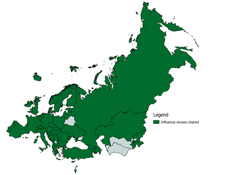Recommendations for the composition of next season’s influenza vaccine released

WHO
WHO’s recommendations for the composition of influenza virus vaccines for use in the 2018–2019 northern hemisphere influenza season have now been released.
Due to the constantly evolving nature of influenza viruses, the compositions of viruses in influenza vaccines need to be revised periodically. Consequently, WHO holds 2 annual consultations – 1 for the northern hemisphere and 1 for the southern hemisphere – to analyse influenza virus surveillance data generated by the WHO Global Influenza Surveillance and Response System (GISRS), and to recommend the composition of the influenza vaccines for the following influenza season.
The recommendations are then used by the national vaccine regulatory agencies and the pharmaceutical companies to develop, produce and license influenza vaccines.
European Region’s contribution to developing the best possible influenza vaccine
These recommendations are made possible by national influenza centres (NICs), which detect and characterize viruses and share them with WHO collaborating centres for in-depth analyses. During the yearly consultation an advisory group of experts analyses the data provided by the countries to recommend the new compositions. This year, NICs in 47 countries of the Region shared viruses which were included in the data analysed and which resulted in the new recommendations.
Changes to previous season’s recommendations
For the influenza viruses to be included in the 2018–2019 northern hemisphere seasonal vaccine, 2 changes are recommended:
- the influenza A(H3N2) component has been replaced by an A/Singapore/INFIMH-16-0019/2016 (H3N2)-like virus to provide better protection against recently circulating influenza A(H3N2) viruses;
- the recommended influenza B/Victoria lineage virus component was changed to a B/Colorado/06/2017-like virus, which has been detected in many countries and which differs antigenically from the B/Brisbane/60/2008-like Victoria lineage virus in the 2017/2018 vaccine.
No changes are recommended for the A(H1N1)pdm09 nor B/Yamagata components.
Final composition
The final composition of the seasonal influenza vaccines for use in the 2018–2019 northern hemisphere influenza season is therefore as follows:
- an A/Michigan/45/2015 (H1N1)pdm09-like virus
- an A/Singapore/INFIMH-16-0019/2016 (H3N2)-like virus
- a B/Colorado/06/2017-like virus (B/Victoria/2/87 lineage)
- a B/Phuket/3073/2013-like virus (B/Yamagata/16/88 lineage).
The first 3 of these are recommended virus strains for inclusion in trivalent influenza vaccines, and the last is a recommended additional virus strain for inclusion in quadrivalent influenza vaccines.
Use of trivalent versus quadrivalent seasonal influenza vaccines
Trivalent vaccines use 3 viruses in their composition, 1 influenza A(H3N2) virus, 1 influenza A(H1N1)pdm09 virus and 1 influenza B virus, while the quadrivalent vaccines use 4 viruses as they include a second influenza B virus of a different lineage.
Current evidence is insufficient to predict which of the influenza B lineages will dominate in the next influenza season in the northern hemisphere. Trivalent vaccines, including influenza B/Victoria lineage viruses could provide some cross-protection against influenza B/Yamagata lineage viruses. In the European Region, out of 32 countries, two thirds use trivalent influenza vaccines according to data submitted in 2017. Among these, 9 countries also used quadrivalent vaccines. Countries may consider evaluating the potential benefits of introducing quadrivalent vaccines, which can provide a broader protection against circulating influenza viruses.
This year’s WHO Consultation and Information Meeting on the Composition of Influenza Virus Vaccines for Use in the 2018–2019 Northern Hemisphere Influenza Season took place on 19–21 February in Geneva, Switzerland.
Vaccination, the most effective measure to prevent severe disease caused by influenza
Influenza vaccines are safe and the principal measure for preventing influenza and reducing the impact of epidemics. WHO recommends that health-care workers and people who are most at risk of developing serious complications from influenza infection – the elderly, people with chronic conditions, pregnant women and young children – be vaccinated every year before the season begins.



